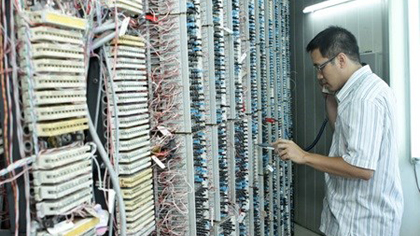Prime Minister approves broadband strategy
The Prime Minister has recently approved a programme to develop broadband telecommunications infrastructure by 2020.
 |
| A worker checks the broadband Internet at VNPT in the northeastern province of Quang Ninh. (Source: VNA) |
Under the programme, at least 40 percent of household and individual subscribers nationwide will have access to fixed broadband internet by 2020.
Also by 2020, at least 60 percent of internet subscribers are to be connected to a minimum speed downlink of 25Mb/s, while 100 percent of public internet access points nationwide will use a fixed broadband service. Of the figure, at least 50 percent of internet access points are to use fixed broadband services with minimum speed downlinks of 50Mb/s.
The programme will also ensure that at least 95 percent of residential areas will be covered by 3G/4G networks with an average downlink speed of over 4Mb/s in urban areas and 2Mb/s in rural areas.
One of the programme's solutions is to focus on service markets that aim to create favourable conditions for every economic sector to participate in the telecommunications market and reduce administrative procedures in granting licences for telecom businesses. The programme also aims to encourage businesses to invest in infrastructure development of broadband telecommunication networks.
It also seeks to create management mechanisms, in line with market mechanisms and healthy competition. Under the programme, no discrimination between State-run and private-run companies is to be allowed.
Further, the programme will focus on promoting the application of digital content, information technologies on broadband telecom infrastructures to meet socio-economic development, such as e-government, e-commerce, and disaster prevention.
Under the guidelines, all people will be permitted to have access to broadband services, while innovations and diversified digital content services will be promoted.
It also asks IT firms to manufacture or assemble end-to-end equipment to minimise production costs.
The programme will further provide solutions for science and technology. Specifically, landline and wireless broadband transmission technologies are to be given priority in development.
It will also encourage enterprises to gradually use core switching networks, as well as advanced network infrastructures for Internet with large capacities and high efficiencies to meet local development and match development trends throughout the world.
(Source: VNA)
 về đầu trang
về đầu trang





